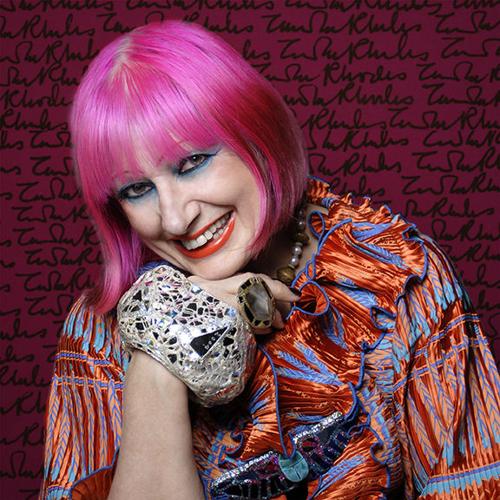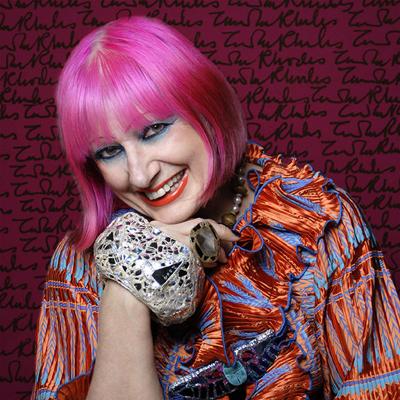Celebrated for her key role in putting punk fashion on the map, iconic designer Zandra Rhodes is known for her unique creativity and boundless energy, splitting her time between London and San Diego, and contributing abundantly to our cultural life here. Having interviewed her last year in her studio in Solana Beach, I was fortunate to be invited back for a "repeat performance."
EM: Zandra, congratulations for your enormous service to San Diego, combining fashion with charity work. Your "Go Red" shows, tying in women’s empowerment with your iconic fashion brand are marvelous.
Zandra: They were wonderfully received. We actually had a standing ovation for "Go Red." Opera singer Priti Gandhi sang at the beginning, and then we had the dress show. It was quite lovely.
EM: How do you do it all?
Zandra: If you live in an area you can’t bury your head in the ground. You get involved. Cardiovascular work happens to be my partner’s main love. We get heavily involved through him. Even if I didn’t want to, we’d be roped in for designing the invitations, doing all the gifts and T-shirts, and other things all passed to us because of that (laughs). If you’re in the community, that’s what you do.
EM: I saw the photo of you in front of that huge poster in Kuala Lumpur. How did that evolve?
Zandra: About 2003, we did an exhibition of my work at the Fashion and Textile Museum in London, that I founded. Since then, that has traveled around the world: Mexico City, Boston and the Mingei here. We were going to Kuala Lumpur to put the exhibition up and they said, "Could you come two months later; it will coincide with a huge British promotion we’re doing called, "Britain is Great - Fashion is Great.’" They asked for another big dress show and put up these huge posters all over the city. We put it all together, posed me in the shopping center in front of this poster. I’ve never seen a longer, taller one.
EM: It must have gotten a lot of attention.
Zandra: I think it probably did. I had a fabulous time.
EM: Tell me about your collection, "Happy Women" prints from the ’60s, described as "retro body-con dresses, oversized print T-shirts, and dresses in bold colors and prints."
Zandra: I’ve done those for a company in Japan called People Tree. They do ethical, sustainable, fair trade fashion, 100 percent organic, so they make sure the crops are grown without killer pesticides. The fabric feels lovely—very soft, beautiful cotton. We went all around, saw the factories in Mumbai, how they were looking after the people working there.
EM: Did you adapt those prints into that particular fabric?

designer Zandra Rhodes-Timothy_Vechik_FINE_magazine
Photos provided by - Timothy Vechik FINE magazine
Zandra: The company did. They chose three designs, fractionally different but based on things I did in the ’60s. Then they chose three new prints and adapted them. They’re done very nicely, some with little white collars. Those are, at the moment, going into the market. So it’s come full circle. It’s rather nice, really.
EM: Do you feel that your designs adapt well from the ’60s to contemporary?
Zandra: I think we’re going through a whole phase of shapes and everything that fits in with all of that—the body-hugging things, the short things, probably shorter than they were in the’60s.
EM: Really? Amen to that! So on to New York and "Punk: Chaos to Couture."
Zandra: Yes, the Met Museum. They had my stuff right at the beginning of the exhibition. It looked very good.
EM: Back in the day, you were called "Princess of Punk." Now, on the Met Museum’s website, you’ve been renamed a "punk hero."
Zandra: Oh, that’s quite good, isn’t it? (Laughs.) Well, that’s very nice. I like that.
EM: How did that journey begin, and how has it morphed over the decades?
Zandra: In the late ’70s—late ’76, early ’77—we’d been doing printed chiffons for maybe ten years and I suddenly thought, "You know what, I feel maybe for safety pins." So I got people in my workroom to sew jewels onto safety pins and then made holes and thought, well, "Why isn’t a hole as decorative as a flower? Why can’t we look at a hole and a tear as being as beautiful as a piece of embroidery?" So I worked on them and turned tears and safety pins into what you could pin a sleeve in a dress, and you could look at it in a different way (http://www.zandrarhodes.com/princess-of-punk-at-met-museum-new-york). Mine is really the haute couture of punk if you’d like to call it that.
EM: How did things progress after ’77, into the ’80s and’90s?
Zandra: In London, on one side you had Vivienne Westwood, who was what you call "Street" because of her boutique in the King’s Road, and was associated with the punk group Sex Pistols. Mine was a gorgeous shop in Bond Street, Mayfair. To look at a hole and a tear as beautiful was a wonderful challenge. My partner at that time said, "If we’re going to do this, we’ve got to do it with conviction." So we filled our windows with fluorescent, shocking pink torn dresses with safety pins, and gorgeous black dresses with beaded safety pins. None of our customers bought them, and we had to put back our lovely chiffons, but because they’re rare—there weren’t a lot of them made—the Philadelphia Museum paid eight thousand dollars for a little skirt and top. The Met wanted to buy the two pieces I had on display with them, but at the moment they’re traveling around the world representing my work, so they said, "Let us know when you want to sell them to us." Ten years after mine, Versace copied the beaded safety pins in the Elizabeth Hurley dress. Suzy Menkes got banned from his show for two years for writing about it in the Herald Tribune.
Photos provided by - Timothy Vechik FINE magazine
EM: How much is punk influencing fashion today?
Zandra: I don't know quite how much. The exhibition to some extent stretched the point a bit. But it was great to be put right at the head of the whole thing as one of the key original influences.
EM: Could you describe the Spring-Summer 2013-2014 London collection?
Zandra: It’s black and white and red and black. There’s quite a lot of drama, with gorgeous colored wigs. We were very lucky; one of the ladies who does the hair for us here in San Diego worked for Vidal Sassoon. We chose to launch it here because now, with the Internet, people see it from there.
Photos provided by - Timothy Vechik for FINE magazine
EM: What lies ahead for you?
Zandra: Gosh, who knows? I’m always open to any project. We’re trying to get together a ready-to-wear line. We’ve got a pre-designed Salome opera, a modern one, with all sorts of exotic dresses, which we’re trying to see if someone’s interested in. That’s all waiting to be worked on.
EM: Zandra, this has all been so enlightening. Thank you so much.
Zandra: Thank you for coming. Wonderful.





(0) comments
We welcome your comments
Log In
Post a comment as Guest
Keep it Clean. Please avoid obscene, vulgar, lewd, racist or sexually-oriented language.
PLEASE TURN OFF YOUR CAPS LOCK.
Don't Threaten. Threats of harming another person will not be tolerated.
Be Truthful. Don't knowingly lie about anyone or anything.
Be Nice. No racism, sexism or any sort of -ism that is degrading to another person.
Be Proactive. Use the 'Report' link on each comment to let us know of abusive posts.
Share with Us. We'd love to hear eyewitness accounts, the history behind an article.